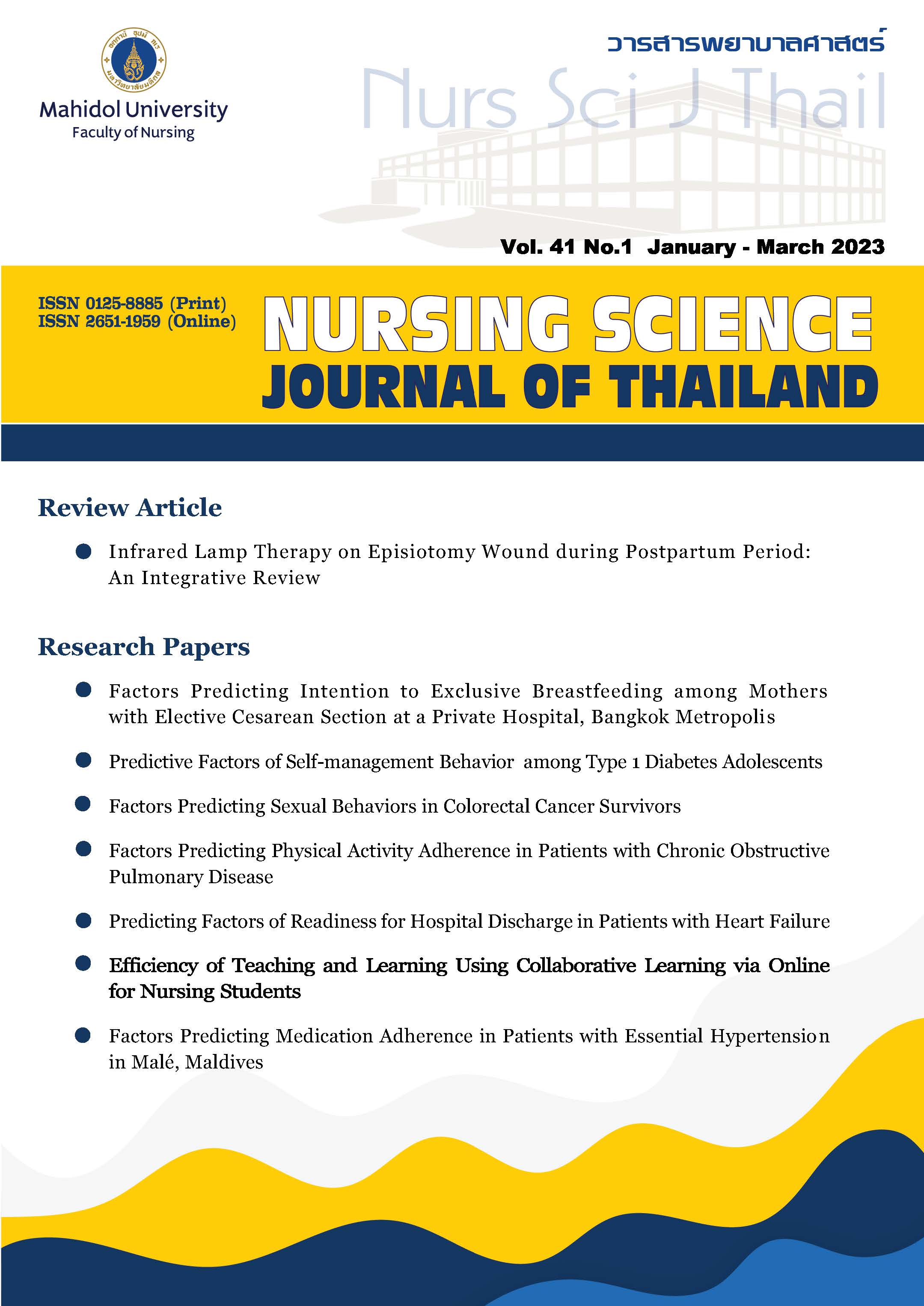ประสิทธิภาพการจัดการเรียนการสอนโดยใช้แนวคิดการเรียนรู้แบบร่วมมือผ่านระบบออนไลน์สำหรับนักศึกษาพยาบาล
Main Article Content
บทคัดย่อ
วัตถุประสงค์: เพื่อศึกษาผลสัมฤทธิ์ทางการเรียนโดยเปรียบเทียบคะแนนสอบความรู้ระหว่างเรียนและหลังเรียน ประสิทธิภาพของการจัดการเรียนการสอนในบทเรียนเรื่องการพยาบาลในระยะคลอดโดยใช้แนวคิดการเรียนรู้แบบร่วมมือผ่านระบบออนไลน์ และความพึงพอใจของนักศึกษาต่อการเรียนรู้แบบร่วมมือผ่านระบบออนไลน์
รูปแบบการวิจัย: การวิจัยกึ่งทดลอง แบบศึกษากลุ่มเดียววัดก่อนและหลัง
วิธีดำเนินการวิจัย: นักศึกษาหลักสูตรพยาบาลศาสตรบัณฑิต ชั้นปีที่ 3 ปีการศึกษา 2564 จำนวน 272 คน ได้รับการจัดการเรียนการสอนเรื่องการพยาบาลในระยะคลอดโดยใช้แนวคิดการเรียนรู้แบบร่วมมือผ่านระบบออนไลน์ ประกอบด้วย 4 ขั้นตอน คือ ขั้นการวางแผนการจัดการเรียนการสอน ขั้นการสอน ขั้นการควบคุมกำกับและการช่วยเหลือดูแล และขั้นการประเมินผลและวิเคราะห์กระบวนการเรียนรู้ เปรียบเทียบคะแนนสอบความรู้ระหว่างเรียนและหลังเรียนด้วยสถิติทดสอบที ทดสอบประสิทธิภาพของการจัดการเรียนการสอนด้วยสูตร E1/E2 และความพึงพอใจของการจัดการเรียนการสอนด้วยสถิติเชิงพรรณนา
ผลการวิจัย: คะแนนสอบหลังการจัดการเรียนการสอนโดยใช้แนวคิดการเรียนรู้แบบร่วมมือผ่านระบบออนไลน์สูงกว่าคะแนนสอบระหว่างเรียนอย่างมีนัยสำคัญทางสถิติ (p < .001) ประสิทธิภาพของการจัดการเรียนการสอนเท่ากับ 83.44/85.56 สูงกว่าเกณฑ์ที่ตั้งไว้ 80/80 และคะแนนความพึงพอใจต่อการจัดการเรียนการสอนโดยรวมอยู่ในระดับมาก ( = 4.32, SD = .76)
สรุปและข้อเสนอแนะ: การจัดการเรียนการสอนโดยใช้แนวคิดการเรียนรู้แบบร่วมมือผ่านระบบออนไลน์นี้มีประสิทธิภาพ ส่งเสริมให้นักศึกษามีทักษะแห่งศตวรรษที่ 21 ด้านความร่วมมือ การทำงานเป็นทีม และภาวะผู้นำ ส่งผลให้มีผลสัมฤทธิ์ทางการเรียนที่ดีขึ้น จึงควรนำแนวคิดการเรียนรู้แบบร่วมมือไปใช้ในบทเรียนหรือวิชาอื่น รวมถึงการศึกษาเปรียบเทียบประสิทธิภาพกับแนวคิดการเรียนรู้แบบอื่น
Article Details

อนุญาตภายใต้เงื่อนไข Creative Commons Attribution-NonCommercial-NoDerivatives 4.0 International License.
ลิขสิทธิ์: วารสารพยาบาลศาสตร์เป็นเจ้าของลิขสิทธิ์ในการเผยแพร่ผลงานที่ตีพิมพ์ ห้ามผู้ใดนำบทความที่ได้รับการตีพิมพ์ในวารสารพยาบาลศาสตร์ไปเผยแพร่ในลักษณะต่างๆ ดังต่อไปนี้ การส่งบทความไปตีพิมพ์เผยแพร่ที่อื่น การนำบทความเผยแพร่ออนไลน์ การถ่ายเอกสารบทความเพื่อกิจกรรมที่ไม่ใช่การเรียนการสอน ยกเว้นเสียแต่ได้รับอนุญาตจากวารสารพยาบาลศาสตร์

Disclaimer: เนื้อหาบทความหรือข้อคิดเห็นใดๆ ในวารสารพยาบาลศาสตร์ ถือเป็นความรับผิดชอบของผู้เขียน กองบรรณาธิการไม่จำเป็นต้องเห็นด้วยและไม่มีส่วนรับผิดชอบแต่อย่างใด
เอกสารอ้างอิง
Roger T, Johnson DW. An overview of cooperative learning. In: Thousand JS, Villa RA, Nevin AI, editors. Creativity and collaborative [Internet]. Baltimore, MD: Paul H. Brookes Publishing; 1994 [cited 2022 Aug 1]. Available from: https://silo.tips/download/an-overview-of-cooperative-learning.
Harvey S, Uren CD. Collaborative learning: application of the mentorship model for adult nursing students in the acute placement setting. Nurse Educ Today. 2019;74:38-40. doi: 10.1016/j.nedt.2018.11.022.
National Association of School Nurses. Framework for 21st century school nursing practiceTM: clarifications and updated definitions. NASN Sch Nurse. 2020;35(4):225-33. doi: 10.1177/1942602X20928372.
Männistö M, Mikkonen K, Kuivila H-M, Virtanen M, Kyngäs H, Kääriäinen M. Digital collaborative learning in nursing education: a systematic review. Scand J Caring Sci. 2020;34(2):280-92. doi: 10.1111/scs.12743.
Williamsona GR, Plowrightb H, Kanec A, Bunced J, Clarkea D, Jamisone C. Collaborative learning in practice: a systematic review and narrative synthesis of the research evidence in nurse education. Nurse Educ Pract. 2020;43:102706. doi: 10.1016/j.nepr.2020.102706.
Farland MZ, Beck DE. Collaborative learning teams to longitudinally teach and assess teamwork behaviors and attitudes. Am J Pharm Educ. 2019;83(9):7255. doi: 10.5688/ajpe7255.
Iqbal MP, Velan GM, O’Sullivan AJ, Balasooriya C. The collaborative learning development exercise (CLeD-EX): an educational instrument to promote key collaborative learning behaviours in medical students. BMC Med Educ. 2020;20(1):62. doi: 10.1186/s12909-020-1977-0.
World Economic Forum. The future of jobs report 2020 [Internet]. Geneva: World Economic Forum; 2020 [cited 2022 Aug 1]. Available from: https://www3.weforum.org/docs/WEF_Future_of_Jobs_2020.pdf.
Le H, Janssen J, Wubbels T. Collaborative learning practices: teacher and student perceived obstacles to effective student collaboration. Camb J Educ. 2018;48(1):103-22. doi: 10.1080/0305764X.2016.1259389.
Zhang J, Cui Q. Collaborative learning in higher nursing education: a systematic review. J Prof Nurs. 2018;34(5):378-88. doi: 10.1016/j.profnurs.2018.07.007.
Roselli ND. Collaborative learning: theoretical foundations and applicable strategies to university. Propósitos y Representaciones. 2016;4(1):219-80. doi: 10.20511/pyr2016.v4n1.90.
Kammanee T. Teaching science: knowledge for learning management process. 23rd ed. Bangkok: Chulalongkorn University; 2021. 512 p. (in Thai).
Saqr M, Fors U, Tedre M. How the study of online collaborative learning can guide teachers and predict students’ performance in a medical course. BMC Med Educ. 2018;18(1):24. doi: 10.1186/s12909-018-1126-1.
Zhang J, Cui Q. Collaborative learning in higher nursing education: a systematic review. J Prof Nurs. 2018;34(5):378-88. doi: 10.1016/j.profnurs.2018.07.007.
Chatterjee R, Correia A-P. Online students’ attitudes toward collaborative learning and sense of community. Am J Distance Educ. 2020;34(1):53-68. doi: 10.1080/08923647.2020.1703479.
Breen H. Virtual collaboration in the online educational setting: a concept analysis. Nurs Forum. 2013;48(4):262-70. doi: 10.1111/nuf.12034.
Suikkala A, Kivelä E, Käyhkö P. Collaborative learning in gerontological clinical settings: the students' perspective. Nurse Educ Pract. 2016;17:229-34. doi: 10.1016/j.nepr.2016.02.006.
Best JW, Kahn JV. Research in education. 8th ed. Allyn & Bacon: Needham Heights, MA; 1997 [cited 2022 Aug 1]. Available from: https://ww2.odu.edu/~jritz/attachments/reined.pdf.
Kanjanavasee S. Classical test theory. 6th ed. Bangkok: Chulalongkorn University; 2013. 301 p. (in Thai).
Brahmawong C. Developmental testing of media and instructional package. Silpakorn Educational Research Journal. 2013;5(1):7-20. (in Thai).
Schnaubert L, Bodemer D. Providing different types of group awareness information to guide collaborative learning. Int J Comput Support Collab Learn. 2019;14(1):7-51. doi: 10.1007/s11412-018-9293-y.
Masters K. Edgar Dale’s pyramid of learning in medical education: a literature review. Med Teach. 2013;35(11):e1584-93. doi: 10.3109/0142159X.2013.800636.
Jaldemark J, Hrastinski S. Olofsson AD, Oberg L-M. Editorial introduction: collaborative learning enhanced by mobile technologies. Br J Educ Technol. 2018;49(2):201-6. doi: 10.1111/bjet.12596.
Santosa EB, Degeng NS, Sulton, Kuswandi D. The effects of mobile computer-supported collaborative learning to improve problem solving and achievements. J Educ Gift Young Sci. 2020;8(1):325-42. doi: 10.17478/jegys.656642.
Shin Y, Kim D, Jung J. The effects of representation tool (visible-annotation) types to support knowledge building in computer-supported collaborative learning. Educ Technol Soc. 2018;21(2):98-110.
Erkens M, Bodemer, D. Improving collaborative learning: guiding knowledge exchange through the provision of information about learning partners and learning contents. Comput Educ. 2019;128:452-72. doi: 10.1016/j.compedu.2018.10.009.


